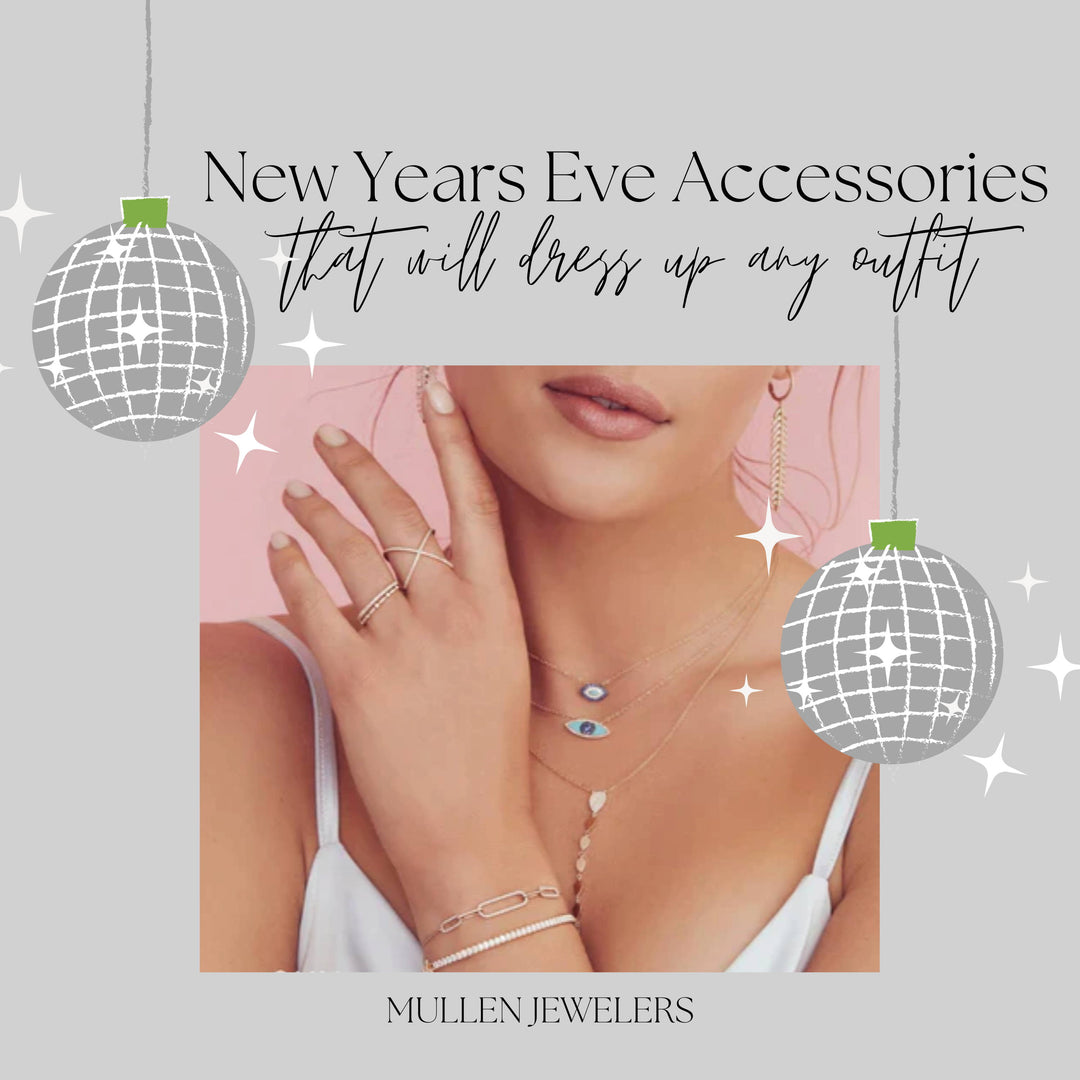All About Diamond Clarity
It's time to return to one of our favorite subjects: diamonds! Yup, we never tire of talking about them, and we've covered a lot about them so far including diamond cuts, 4 C's of diamonds, the other 2 C's of diamonds, diamond shape, diamond color, oval-, cushion-, princess-, emerald-, and fancy-shaped diamonds and now it's time to talk about...diamond clarity!
Clarity is one of the 4Cs of diamond classification or grading—carat, cut, color, and clarity—and simply refers to the existence and visual appearance of internal characteristics of a diamond called inclusions and surface defects called blemishes.
Blemishes are usually easier to see than inclusions, and occasionally may be located using the naked eye. Inclusions typically can’t be seen by the naked eye—however, if a very large inclusion can be seen without a special magnifying lens called a loupe, then the diamond is usually deemed as poor quality.
It's important to understand that most diamonds have these have tiny imperfections known as inclusions, and the less visible the inclusions, the higher the clarity grade. In fact, diamond clarity is often considered the least important of the 4Cs because most of these inclusions are microscopic, so they don’t affect the diamond’s beauty in an overt or obvious way!
WHERE DO INCLUSIONS AND BLEMISHES COME FROM?
Diamonds take a long, long, long time to form, and during this formation period they get flaws and imperfections along the way. Inclusions are solids, liquids, or gases that were trapped in the diamond as it was developing. These may be crystals of foreign matter or even another diamond crystal. The diamond may also have structural imperfections that make it appear whitish or cloudy.
The number, size, color, location, orientation, and visibility of inclusions can all affect the clarity of a diamond. A clarity grade is given based on the overall appearance of the diamond under ten times magnification. Diamonds are classified using a 10x Loupe—a special magnifying lens used by jewelers to get a close-up look at things that might not be seen with the naked eye.
With inclusions, oftentimes the diamond cutter will try and position the inclusion in such a way that minimizes it , such as positioning it close to the diamond's girdle. The diamond girdle is the thin perimeter of a diamond that divides the crown above from the pavilion below. Inclusions that are located next to the girdle are harder to see and will have less effect on the brilliance of the diamond.
HOW DIAMOND CLARITY IS DETERMINED
The clarity of a polished diamond is graded on a scale ranging from Flawless (FL) to Included Grade 3 (I3). Flawless diamonds have no visible inclusions or blemishes. Remember, flawless diamonds are exceedingly rare and very expensive, only around 0.02% of all the diamonds produced are flawless!
THE SCALE OF DIAMOND CLARITY
The GIA Diamond Clarity Scale has 6 categories, some of which are further broken down, which gives a total of 11 specific grades. The diamond clarity grades are as follows:
- Flawless (FL) No inclusions and no blemishes visible under 10x magnification
- Internally Flawless (IF) No inclusions visible under 10x magnification
- Very, Very Slightly Included (VVS1 and VVS2) Inclusions so slight they are difficult for a skilled grader to see under 10x magnification
- Very Slightly Included (VS1 and VS2) Inclusions are observed with effort under 10x magnification, but can be characterized as minor
- Slightly Included (SI1 and SI2) Inclusions are noticeable under 10x magnification
- Included (I1, I2, and I3) Inclusions are obvious under 10x magnification which may affect transparency and brilliance
A couple of things to remember about diamond clarity. Again, a flawless diamond is super expensive and rare. Many inclusions and blemishes are too tiny to be seen by anyone other than a trained diamond expert or jeweler. If you cannot detect flaws or blemishes in a diamond when looking through the crown of it (the portion of the diamond between its girdle and its table), most likely nobody else will either!
We've said this before and we will say it again: the most important thing to remember when picking the perfect diamond and considering the 4 Cs is that "perfect" means different things to different people. Pick with your eyes and your heart, don't break your budget (you'll regret this later!), and go with what you love. You can't go wrong with this! There is the perfect diamond out there for you and we would be thrilled to help you find it
Here are some beautiful diamonds to consider if you are just starting on your hunt for the perfect diamond engagement ring...
Diamond Engagement Rings
We're honored that Mullen Bros. Jewelers ranks #1 in overall customer ratings among all jewelry stores in Southeastern Massachusetts and we will continue to take care of our neighbors and friends, one jewel at a time.

Explore more
- 3 Diamond Jewelry Pieces Every Woman Needs
- Alison Kauffman Jewelry
- all about diamond shapes
- all about diamond color
- all about diamond cuts
- all about earrings
- all about earrings types of earrings
- all about fancy shaped diamonds
- all about fancy shaped diamonds all about fancy cut diamonds
- All About Prong Ring Settings
- Alternative Engagement Rings
- anniversary bands
- anniversary gifts
- April birthstone Jewelry
- Are Cocktail Rings the same as Statement Rings?
- asscher cut diamonds
- bangles
- basic jewelry care
- basic jewelry guide
- basic jewelry pieces every woman must have
- basic jewelry wardrobe
- best gifts for your bridesmaids
- bezel setting
- Birthstone Amethyst Jewelry
- birthstone jewelry
- Blue Topaz
- blue topaz birthstone jewelry
- blue topaz jewelry
- bracelets
- Bridesmaid's gifts
- bright bold jewelry
- brilliant cut diamonds
- Bypass style engagement rings
- Carla Corporation
- Carla Corporation Jewelry
- channel setting
- charms
- christmas gifts for him
- Christmas Jewelry Gifts for her
- Citizen Watches
- citrine birthstone facts
- citrine birthstone jewelry
- citrine jewelry
- cluster diamond engagement rings
- cluster setting
- Cocktail Rings
- Cushion Cut Diamond Engagement Rings
- Cushion Cut Diamond Rings
- Cushion Cut Diamonds
- custom made wedding bands
- custom wedding bands
- definition of a carat
- diamond clarity
- Diamond cocktail rings
- diamond color
- diamond cut
- Diamond earrings
- Diamond Education
- diamond engagement ring settings
- diamond engagement rings
- diamond engagement rings under $3000
- diamond engagement rings with side stones
- diamond halo engagement rings
- diamond jewelry
- Diamond necklaces
- diamond solitaire engagement ring
- difference between a gypsy and bezel setting
- difference between carat and karat
- difference between diamond shape and diamond cut
- difference between fancy shape and fancy cut diamonds
- different types of promise rings
- Drop Earrings
- earring backs
- Earrings at the 2018 Emmy's
- easy valentine's jewelry gifts
- edgy pearls
- edwardian engagement rings
- edwardian wedding sets
- Emerald Cut Diamond Engagement Rings
- emerald cut diamonds
- emerald jewelry
- engagement
- Engagement Ring Education
- engagement ring question you may be embarrassed to ask
- Engagement Ring Questions
- Engagement Ring Terminology
- Engagement Ring Terms
- Engagement Ring Trends 2017
- engagement rings
- engagement rings under $3000
- fall themed jewelry
- fancy cut diamond engagement rings
- fancy cut diamonds
- fancy shaped diamond engagement rings
- fancy shaped diamonds
- Fashion Jewelry News
- February Birthstone Amethyst
- finding the perfect anniversary gift
- flush mount setting
- Frederick Goldman
- Frederick Goldman Jewelry
- Gabriel & Co. New York
- Gabriel & Co. New York Engagement Rings
- Gabriel & Co. New York Fashion Jewelry
- Gabriel and Company New York
- Garnet Birthstone Jewelry
- geometric jewelry
- Get the 2019 Oscar Jewelry Look
- Get the Perfect Engagement Ring Selfie
- getting the perfect surprise proposal picture
- GIA Diamond Color Scale
- gift ideas for mom
- golden globes 2018
- golden globes hot jewelry looks 2017
- Golden Globes Top Jewelry Moments
- green colored jewelry
- gypsy setting
- halo ring setting
- hiding your engagement ring before popping the question
- History of Movado
- Holiday Gift Guides
- holiday gifts for him
- holiday gifts under $300
- Holiday jewelry for under $200
- holiday jewelry trends 2016
- Hot Jewelry for Summer
- how to achieve the layered necklace look
- how to figure out your girlfriend's engagement ring size
- how to figure out your girlfriend's ring size
- how to get a diamond engagement ring on a budget
- How to Get the Perfect Engagement Ring Photo
- how to get the perfect surprise proposal picture
- how to layer necklaces
- how to pick an oval diamond engagement ring
- how to pick the right watch
- How to save for your engagement ring
- how to store your jewelry
- how to take care of your jewelry
- how to travel with jewelry
- Including Pets in Your Wedding Proposal
- invisible setting
- is a diamond's color important
- January birthstone
- January Birthstone Garnet
- Jewelry Education
- jewelry every woman must have
- jewelry for valentine's day
- Jewelry Gift Guides
- Jewelry Gift Ideas
- Jewelry Ideas for Mom
- jewelry ideas for mother's day
- jewelry trends 2016
- jewelry trends 2017
- jewelry trends for 2018
- Jewelry under $1000
- jewelry under $500
- jewelry wardrobe
- John Medeiros Jewelry Collection
- July Birthstone Jewelry
- July birthstone Ruby
- July Birthstone Ruby Jewelry
- june birthstone alexandrite
- June birthstone Moonstone
- June birthstone pearl
- Kendra Scott
- Kendra Scott Jewelry
- kinds of promise rings
- Lady Gaga's Engagement Ring
- lafonn jewelry
- last minute christmas gift ideas
- last minute gift ideas
- last minute holiday gift ideas
- layered look
- layering necklaces
- London Blue Topaz
- March birthstone aquamarine
- march birthstone jewelry
- May Birthstone Emerald
- men's watches
- men's wedding bands
- Merry Christmas 2015
- Michael Kors Watches
- Mismatched Earrings
- morganite
- morganite engagement rings
- morganite jewelry
- morganite rings
- Mother's Day Gift Ideas
- mother's day gifts
- Mother's Day Jewelry Gift Ideas
- Movado
- Movado Watches
- Non-Traditional Engagement Rings
- October Birthstone Jewelry
- October Birthstone Opal
- October Birthstone Tourmaline
- orange and gold jewelry
- oval cut diamonds
- oval diamond engagement rings
- oval diamonds
- Paris Hilton Lost Her Engagement Ring
- Paris Hilton's Diamond Engagement Ring
- Pear Shaped Diamond Engagement Ring
- pear shaped diamonds
- pear shaped jewelry
- pearls
- perfect jewelry gifts for mother's day
- perfect surprise proposal pictures
- peridot
- peridot birthstone jewelry
- peridot facts
- pets and your proposal
- picking the perfect anniversary gifts
- picking the right watch
- Pippa Middleton's engagement ring
- Pippa Middleton's wedding rings
- popular styles of promise rings
- Princess cut diamond
- princess cut diamond engagement ring
- princess cut engagement ring
- promise ring
- promise rings
- prong setting
- prong setting jewelry
- pros and cons of a prong setting
- rhythm of love jewelry
- rose gold
- Rose Gold Diamond Engagement Rings for 2018
- rose gold jewelry
- round cut diamonds
- round diamond engagement rings
- round diamonds
- round shape diamonds
- sapphire
- sapphire birthstone jewelry
- Sapphire Diamond Engagement Rings for 2018
- sapphire earrings
- sapphire jewelry
- sapphire necklaces
- sapphire rings
- secrets to layering necklaces
- smart ways to get a bigger engagement ring
- smart ways to save for your engagement ring
- sneaky ways to figure out her ring size
- solitaire diamond
- solitaire diamond engagement ring
- solitaire engagement ring
- St. Patrick's Day
- stacked enagement ring sets
- stacked engagement rings
- stacked rings
- stacked wedding ring sets
- stacked wedding rings
- Statement Necklaces
- statement rings
- summer jewelry
- Summer Jewelry Looks
- Swiss Blue Topaz
- The Best Jewelry at the 2019 SAG Awards
- the best way to wear a watch
- The History of the Cocktail Ring
- Ti Sento - Milano
- Ti Sento - Milano Jewelry
- tips for layering necklackes
- top 10 valentine's day heart jewelry gift ideas
- top jewelry trends 2017
- Two Tone Gold Jewelry
- two-tone jewelry
- twogether jewelry
- types of earrings
- understanding ring setting techniques
- Unique ways to hide your engagement ring
- unique wedding bands
- Upgrading Your Engagement Ring
- v-prong setting
- Valentine's Day Gift Ideas
- valentine's day heart jewelry
- valentine's day jewelry
- Valentine's Day Jewelry Gift Ideas
- valentine's jewelry
- valentine's jewelry for her
- Video Music Awards 2018
- vintage diamond engagement rings
- Vintage Diamond Engagement Rings for 2018
- vintage inspired engagement rings
- watche styles to suit every man
- watches for every man
- watches for him
- wearing watches with style
- wedding band weekend
- wedding bands
- wedding bands for men
- What Do You Do If You Lost Your Diamond Engagement Ring
- what is a carat
- what is a promise rings
- what is morganite
- what is rose gold
- White and Gold Jewelry
- whitehouse brothers
- Why Wear a Watch
Share this
From the blog
View all- 3 Diamond Jewelry Pieces Every Woman Needs
- Alison Kauffman Jewelry
- all about diamond shapes
- all about diamond color
- all about diamond cuts
- all about earrings
- all about earrings types of earrings
- all about fancy shaped diamonds
- all about fancy shaped diamonds all about fancy cut diamonds
- All About Prong Ring Settings
- Alternative Engagement Rings
- anniversary bands
- anniversary gifts
- April birthstone Jewelry
- Are Cocktail Rings the same as Statement Rings?
- asscher cut diamonds
- bangles
- basic jewelry care
- basic jewelry guide
- basic jewelry pieces every woman must have
- basic jewelry wardrobe
- best gifts for your bridesmaids
- bezel setting
- Birthstone Amethyst Jewelry
- birthstone jewelry
- Blue Topaz
- blue topaz birthstone jewelry
- blue topaz jewelry
- bracelets
- Bridesmaid's gifts
- bright bold jewelry
- brilliant cut diamonds
- Bypass style engagement rings
- Carla Corporation
- Carla Corporation Jewelry
- channel setting
- charms
- christmas gifts for him
- Christmas Jewelry Gifts for her
- Citizen Watches
- citrine birthstone facts
- citrine birthstone jewelry
- citrine jewelry
- cluster diamond engagement rings
- cluster setting
- Cocktail Rings
- Cushion Cut Diamond Engagement Rings
- Cushion Cut Diamond Rings
- Cushion Cut Diamonds
- custom made wedding bands
- custom wedding bands
- definition of a carat
- diamond clarity
- Diamond cocktail rings
- diamond color
- diamond cut
- Diamond earrings
- Diamond Education
- diamond engagement ring settings
- diamond engagement rings
- diamond engagement rings under $3000
- diamond engagement rings with side stones
- diamond halo engagement rings
- diamond jewelry
- Diamond necklaces
- diamond solitaire engagement ring
- difference between a gypsy and bezel setting
- difference between carat and karat
- difference between diamond shape and diamond cut
- difference between fancy shape and fancy cut diamonds
- different types of promise rings
- Drop Earrings
- earring backs
- Earrings at the 2018 Emmy's
- easy valentine's jewelry gifts
- edgy pearls
- edwardian engagement rings
- edwardian wedding sets
- Emerald Cut Diamond Engagement Rings
- emerald cut diamonds
- emerald jewelry
- engagement
- Engagement Ring Education
- engagement ring question you may be embarrassed to ask
- Engagement Ring Questions
- Engagement Ring Terminology
- Engagement Ring Terms
- Engagement Ring Trends 2017
- engagement rings
- engagement rings under $3000
- fall themed jewelry
- fancy cut diamond engagement rings
- fancy cut diamonds
- fancy shaped diamond engagement rings
- fancy shaped diamonds
- Fashion Jewelry News
- February Birthstone Amethyst
- finding the perfect anniversary gift
- flush mount setting
- Frederick Goldman
- Frederick Goldman Jewelry
- Gabriel & Co. New York
- Gabriel & Co. New York Engagement Rings
- Gabriel & Co. New York Fashion Jewelry
- Gabriel and Company New York
- Garnet Birthstone Jewelry
- geometric jewelry
- Get the 2019 Oscar Jewelry Look
- Get the Perfect Engagement Ring Selfie
- getting the perfect surprise proposal picture
- GIA Diamond Color Scale
- gift ideas for mom
- golden globes 2018
- golden globes hot jewelry looks 2017
- Golden Globes Top Jewelry Moments
- green colored jewelry
- gypsy setting
- halo ring setting
- hiding your engagement ring before popping the question
- History of Movado
- Holiday Gift Guides
- holiday gifts for him
- holiday gifts under $300
- Holiday jewelry for under $200
- holiday jewelry trends 2016
- Hot Jewelry for Summer
- how to achieve the layered necklace look
- how to figure out your girlfriend's engagement ring size
- how to figure out your girlfriend's ring size
- how to get a diamond engagement ring on a budget
- How to Get the Perfect Engagement Ring Photo
- how to get the perfect surprise proposal picture
- how to layer necklaces
- how to pick an oval diamond engagement ring
- how to pick the right watch
- How to save for your engagement ring
- how to store your jewelry
- how to take care of your jewelry
- how to travel with jewelry
- Including Pets in Your Wedding Proposal
- invisible setting
- is a diamond's color important
- January birthstone
- January Birthstone Garnet
- Jewelry Education
- jewelry every woman must have
- jewelry for valentine's day
- Jewelry Gift Guides
- Jewelry Gift Ideas
- Jewelry Ideas for Mom
- jewelry ideas for mother's day
- jewelry trends 2016
- jewelry trends 2017
- jewelry trends for 2018
- Jewelry under $1000
- jewelry under $500
- jewelry wardrobe
- John Medeiros Jewelry Collection
- July Birthstone Jewelry
- July birthstone Ruby
- July Birthstone Ruby Jewelry
- june birthstone alexandrite
- June birthstone Moonstone
- June birthstone pearl
- Kendra Scott
- Kendra Scott Jewelry
- kinds of promise rings
- Lady Gaga's Engagement Ring
- lafonn jewelry
- last minute christmas gift ideas
- last minute gift ideas
- last minute holiday gift ideas
- layered look
- layering necklaces
- London Blue Topaz
- March birthstone aquamarine
- march birthstone jewelry
- May Birthstone Emerald
- men's watches
- men's wedding bands
- Merry Christmas 2015
- Michael Kors Watches
- Mismatched Earrings
- morganite
- morganite engagement rings
- morganite jewelry
- morganite rings
- Mother's Day Gift Ideas
- mother's day gifts
- Mother's Day Jewelry Gift Ideas
- Movado
- Movado Watches
- Non-Traditional Engagement Rings
- October Birthstone Jewelry
- October Birthstone Opal
- October Birthstone Tourmaline
- orange and gold jewelry
- oval cut diamonds
- oval diamond engagement rings
- oval diamonds
- Paris Hilton Lost Her Engagement Ring
- Paris Hilton's Diamond Engagement Ring
- Pear Shaped Diamond Engagement Ring
- pear shaped diamonds
- pear shaped jewelry
- pearls
- perfect jewelry gifts for mother's day
- perfect surprise proposal pictures
- peridot
- peridot birthstone jewelry
- peridot facts
- pets and your proposal
- picking the perfect anniversary gifts
- picking the right watch
- Pippa Middleton's engagement ring
- Pippa Middleton's wedding rings
- popular styles of promise rings
- Princess cut diamond
- princess cut diamond engagement ring
- princess cut engagement ring
- promise ring
- promise rings
- prong setting
- prong setting jewelry
- pros and cons of a prong setting
- rhythm of love jewelry
- rose gold
- Rose Gold Diamond Engagement Rings for 2018
- rose gold jewelry
- round cut diamonds
- round diamond engagement rings
- round diamonds
- round shape diamonds
- sapphire
- sapphire birthstone jewelry
- Sapphire Diamond Engagement Rings for 2018
- sapphire earrings
- sapphire jewelry
- sapphire necklaces
- sapphire rings
- secrets to layering necklaces
- smart ways to get a bigger engagement ring
- smart ways to save for your engagement ring
- sneaky ways to figure out her ring size
- solitaire diamond
- solitaire diamond engagement ring
- solitaire engagement ring
- St. Patrick's Day
- stacked enagement ring sets
- stacked engagement rings
- stacked rings
- stacked wedding ring sets
- stacked wedding rings
- Statement Necklaces
- statement rings
- summer jewelry
- Summer Jewelry Looks
- Swiss Blue Topaz
- The Best Jewelry at the 2019 SAG Awards
- the best way to wear a watch
- The History of the Cocktail Ring
- Ti Sento - Milano
- Ti Sento - Milano Jewelry
- tips for layering necklackes
- top 10 valentine's day heart jewelry gift ideas
- top jewelry trends 2017
- Two Tone Gold Jewelry
- two-tone jewelry
- twogether jewelry
- types of earrings
- understanding ring setting techniques
- Unique ways to hide your engagement ring
- unique wedding bands
- Upgrading Your Engagement Ring
- v-prong setting
- Valentine's Day Gift Ideas
- valentine's day heart jewelry
- valentine's day jewelry
- Valentine's Day Jewelry Gift Ideas
- valentine's jewelry
- valentine's jewelry for her
- Video Music Awards 2018
- vintage diamond engagement rings
- Vintage Diamond Engagement Rings for 2018
- vintage inspired engagement rings
- watche styles to suit every man
- watches for every man
- watches for him
- wearing watches with style
- wedding band weekend
- wedding bands
- wedding bands for men
- What Do You Do If You Lost Your Diamond Engagement Ring
- what is a carat
- what is a promise rings
- what is morganite
- what is rose gold
- White and Gold Jewelry
- whitehouse brothers
- Why Wear a Watch












Leave a comment